Chord Theory: The Ultimate Guide to Piano Harmony
Chord theory is a musician’s best friend.
Now, why exactly is that? It’s because it’s a system that helps you understand what chords you need to use in a given song. It also helps when playing whatever style of music you might encounter.
 Fortunately, the piano is a very visual instrument. This makes it very easy for us to understand how chord theory works.
Fortunately, the piano is a very visual instrument. This makes it very easy for us to understand how chord theory works.
Have you ever wondered what those chord symbols really are? Here we now discuss how to read and play those chord symbols.
The Major Scale in Chord Theory
I’m going to tell you a huge shortcut right now. Remember the first scale that most people learn called the major scale?
Guess what, 95% of the chords you learn will use this easy scale as a building block!
Whenever we describe chord names and chord theory, it’s always in reference to a major scale. So, if you want to understand those crazy chord names, know your major scale: it forms the basis for our chord theory.
A major scale…
- …is a seven-note array of notes.
- …starts with a note we call the “root”.
- …has notes separated from one another by a specific series of whole steps (W) and half steps (h), the pattern is W-W-h-W-W-W-h
To breeze through chord theory, we need to name all the seven notes of the major scale in the following order. We will call these names the scale degrees.
The names of the scale degrees are in reference to their interval (i.e. the distance from one note to the next) from the root:
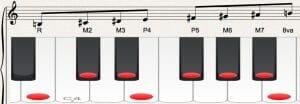
- Root or unison (R).
- Major 2nd (M2).
- Major 3rd (M3).
- Perfect 4th (P4).
- Perfect 5th (P5).
- Major 6th (M6).
- Major 7th (M7).
If you want a deeper understanding of major scales, go on and read Major Piano Scales: Awesome Mastery Tutorial and/or Piano Major Scales: How To Build and Play Them in Any Key.
Now that you understand the basics of the major scale, let’s use it to start learning all those sweet chords!
Chord Theory Basics
A lot of people make chords more complicated than they need to be. Here’s an easy to think about chords going forward. Simply put, it’s just a combo of two notes or more put together.
1. Power Chord Theory
The smallest chord you can get is called a power chord. Power chords are nothing more than the root and the perfect 5th played together.
For example, C plus G is a C power chord or C5 (meaning the note C plus the perfect 5th):
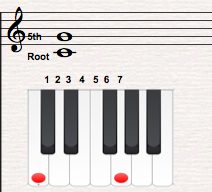
To play a power chord on the piano, play any note plus another note seven half steps away from it.
Power chords are “neutral” sounding in quality i.e. neither “happy” or “sad”. The perfect 5th thickens the sound of the root note.
When you’re playing something heavy or ballsy like hard rock, punk, or metal, power chords are the way to go.
2. How to Spell Out Triads
Now that you understand the basics of 2 note chords, lets talk about 3 note chords. A 3 note chord is often called a triad.
Chord theory defines a triad as a combination of notes starting with a root plus a third and a fifth. For instance the C major triad is C, E, and G:
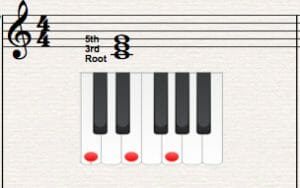
Another example is Gb, which is Gb, Bb, and Db:
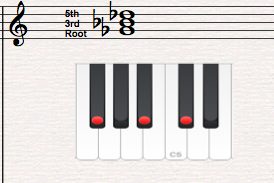
VERY IMPORTANT: We spell chords to always represent a root + third + fifth relationship. What I mean to say is when you spell out your chord, it has to appear that you’re skipping letters of the alphabet.
For example, although Gb, A#, and Db sounds as a Gb major chord, the correct spelling of the chord is Gb, Bb, and Db (Gb to A# is an augmented 2nd while Gb to Bb is a major 3rd, even though they will sound the same on the piano).
2. Major Chord Theory
Want to sound happy and bright? Major chords are the way to go!
A major triad consists of a root plus a major 3rd (four half steps away from the root) and a perfect 5th (three half steps away from the major 3rd). For example, here’s a C major triad:
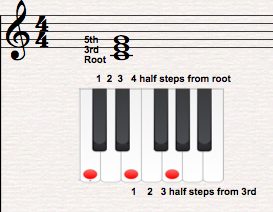
As an example of major chords being used in actual songs, check out this neat Amazing Grace piano lesson.
4. Minor Chord Theory
A minor triad is the opposite of a major chord. It has a root, a minor 3rd (three half steps away from the root), and a perfect 5th (four half steps away from the minor 3rd):
Here is a C minor chord (Cm or Cmin):
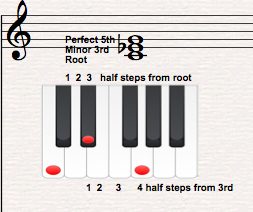
Minor chords have that “sad” or “dark” quality. This Let It Be Piano Chords lesson shows how using a minor chord can add tension or contrast to start a new song section.
5. Diminished Chord Theory
If you want to add a little bit of tension, uneasiness, or even try and spook someone out in your music, diminished chords are your go-to chords.
A diminished triad has a root, a minor third (three half steps away from the root), and a diminished fifth (three half steps away from the minor third):
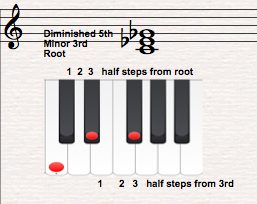
For an example of how to use a diminished chord, check out this lesson on Plush Chords by the Stone Temple Pilots.
6. Augmented Chord Theory
If you want to take people away into feelings of dreams, fantasy, flights of mystery and wonder, augmented chords are the key.
An augmented triad has a root, a major 3rd (four half steps away from the root), and an augmented 5th (four half steps away from the major 3rd).
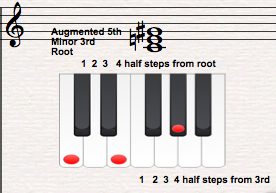
7. Chord Theory on Sevenths
To add a bit more character to the basic triad, you can add sevenths (i.e. notes that have an interval of a seventh from the root). Here you will discover what these seventh chords are all about:
a. Major Seventh Chords
Major seventh chords are major chords with a major 7th added to it. For example, we have Cmaj7 as a C (C + E + G) with a “maj7” (B):
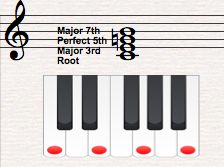
Major seventh chords are what most people think of when they say “jazzy”. These chords are kind of like a happy or bright sound with an added element of “cool” or “relaxation” feel to it.
b. Minor Seventh Chords
Minor seventh chords are minor chords with a minor 7th or flattened 7th (“7”, yes, the plain number “7”, is always the flat or minor 7th in chord theory) e.g. Cmin7 is a Cmin chord (C, Eb, G) with a minor 7th (the “7” is Bb):
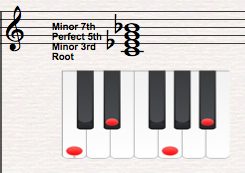
Minor seventh chords have that sad minor blues or jazzy sounding effect.
c. Dominant Seventh Chords
In chord theory, if you want to make your listeners feel that something is coming up next, use the dominant seventh chord. This chord is known mostly for three things:
- It is a chord that typically leads or transitions to the first chord in a particular key signature e.g. G7 naturally leads to either C or Cmin (or any variation of it).
- In chord theory, it is a pivot chord i.e. a series of dominant seventh chords (called secondary dominants) can be used to change key signatures e.g. G7 then C7 then F or Fmaj7 (the first chord in the key of F).
- They are the blues chords. Most blues songs consist entirely of dominant seventh chords.
Dominant seventh chords do a really good job of linking from one chord to the next. I even once heard that John Williams (yes, the famous Hollywood film composer) uses them like you would use “and” in a sentence!
To form a dominant seventh chord, add a flat 7th (“7”) to any major triad. For example C7 is the C chord (C, E, G) plus the “7” (Bb):
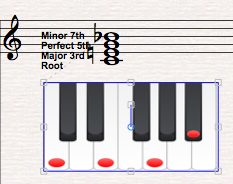
Because of its nature as a chord that would typically lead to the first chord of a key signature, the dominant seventh chord has that “hanging” feel to it.
In this Hallelujah Piano lesson, watch out how that E7 chord leads nicely to an Am chord.
d. Minor Seventh (Flat Five) Chords
A minor seventh (flat five) chord is a minor chord with the fifth flattened (this is technically a diminished triad) plus a flat 7th (“7”):
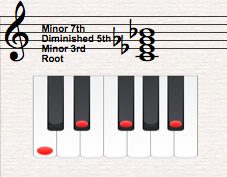
Also known as a “half diminished” chord, It has a kind of “unsettled” feel that easily leads to a dominant seventh chord.
e. Minor (Major Seventh) Chords
One of the most confusing chords in the history of chord theory is the minor (major seventh) chord. It is a minor triad with a “maj7”:
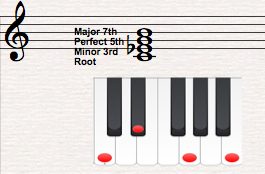
This kind of minor chord has kind of a “dark” yet “jazzy” feel to it.
f. Diminished Seventh Chords
The diminished seventh chord (or “full diminished” chord) is a diminished triad plus a diminished seventh (move a flat 7th a half step back). For instance, a Cdim has C, Eb, Gb, and Bbb:
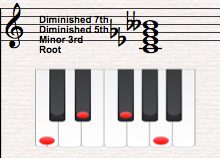
Remember, you can’t call Bbb as A, although they are enharmonic, because of chord theory naming conventions. A diminished seventh chord has that really unsettling feel that makes your ears look for a more consonant sounding chord to go to next.
g. Augmented Seventh Chords
An augmented seventh chord is nothing more than an augmented triad plus a “7” (flat 7th):
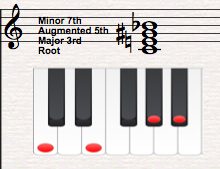
Augmented seventh chords have that “dreamy” yet “unsettled” quality as well. Most jazz musicians call this chord a dominant 7th flat 13 chord instead i.e. this example shows a C7(b13).
8. Sixth Chord Theory
In chord theory, when you see something like a C6, it simply means a C major triad (C, E, G) plus the major sixth note (A):
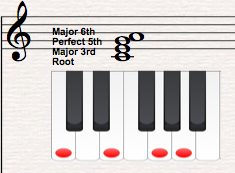
From a technical chord theory standpoint, this is one of the most consonant sounding chords you can hear.
9. Suspended Chord Theory
Suspended chords have a kind of “hanging” feel to them; they always resolve to a triad. We usually play these chords just right before a dominant seventh chord.
a. Sus4 Chord
A sus4 chord has a root, its perfect 4th, and the perfect 5th. For example, a Gsus4 chord is G, C, and D:
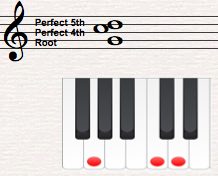
A sus4 chord is never a final chord in many cases. It almost always resolves to a major triad. Check out this example:

b. Sus2 Chord
The sus2 chord has a root, a major 2nd, and a perfect 5th. A Gsus2 chord (G, A, D) looks like this:
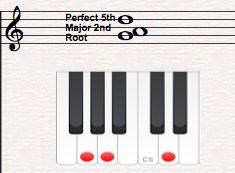
Like the sus4, the sus2 chord is never a final chord because its sound leaves you hanging, expecting for something. Here’s an example of how you use a sus2 chord:

Chord Names
Chord names can sometimes get very confusing. I know. I’ve been there. So, how do we actually name chords?
In chord theory, this is how we do it:
[Root Note] + [Triad Quality] + [Extension/s]
Following the formula above, we can get Cmin(maj7) as follows:
[C] + [min] + [maj7]
- A plain major triad is named is simply named after the root note e.g. C is simply C + E + G, D is D + F# + A.
- A plain minor triad will have the triad quality “m” or “min” attached to it e.g. Cmin or Cm is C + Eb + G.
- A “dim” or “°” sign attached to a note letter name means the chord is diminished. For example, Cdim or C° means the chord is C + Eb + Gb.
- An “aug” or “+” sign attached to a note letter name means the chord is augmented. For example, Caug or C+ means C + E + G#.
- A tag “maj7” attached to any chord name (whether major or minor) means that there is a major 7th (11 half steps) away from the root added to the triad. For example, Cmaj7 is C + E + G + B (major 7th from C). Cmin(maj7) is C + Eb + G +B.
- A plain “7” attached to any chord name (whether major or minor) means a minor or a flattened 7th is attached to the triad.
- A “sus” tag means the chord is a suspended chord. It is usually sus4. Otherwise, sus4 or sus2 would be written out to be more specific.
- Other extensions that might be added include numbers higher than 8 in parenthesis like 9 (a 9th away from the root note), 11, and 13. These numbers can also be given accidentals right before them meaning that they’re either sharp or flat.
Finding the “Right Chords” in a Key Signature
 To easily find out the chords that would naturally exist in a given key signature or scale, you can draw a chart with at least three rows as shown below.
To easily find out the chords that would naturally exist in a given key signature or scale, you can draw a chart with at least three rows as shown below.
This is a way of making chord theory a whole lot easier.
Our example is in the key of C:

How to Draw Your Own Chord Theory Table
- First row has the notes of the scale starting at the root note.
- Second row has the notes of the scale starting at the third note of the scale.
- Third row has the notes of the scale starting at the fifth note of the scale.
After you draw your table correctly, you can find out the kind of chords charted by playing them and/or using the chord theory formulas you have just read about i.e. how to form a major chord, etc.
Them Pesky Roman Numerals!
 Now you might ask, “What are all those Roman numerals?”.
Now you might ask, “What are all those Roman numerals?”.
Those Roman numerals are our chord names in scale degrees.
This is what most musicians refer to when they talk of things like the “I” chord, “ii” chord, etc.
Roman numerals in uppercase have major 3rds from the root and those in lowercase are chords that have a minor 3rd from the root.
Uppercase chords that have a “+” are augmented chords, and those that have a “o” sign are diminished chords.
Check out this neat lesson about piano chord progressions: I, IV, V, IV to get a hang of how we use Roman numerals to refer to chords.
Here’s an example of how chord theory works in many songs: The I vi IV V chord progression is one of the most common chord sequences in many songs:
I vi IV V: Easy And Fun Chord Progression Tutorial
What’s In It for Me To Learn Chord Theory This Way?
Now, why would you try to learn chord theory this way ? Here are some benefits:
- You will instantaneously know what chords sound good in songs.
- You’ll be able to predict what chords to expect in songs in any key signature.
- You can easily learn new songs when you know where certain chords fit.
The next step is checking out how to play these chords more effectively. Go ahead and try out our chord inversions lesson.
I hope that this guide has brought you closer to understanding chords and how to actually use them in various examples. If you enjoyed this lesson, have questions, or any comments about it, please leave a comment below.
For more awesome piano lessons that go straight into your inbox, go ahead and subscribe to the pianolessonsonline.com free mailing list. Go to the upper right hand corner of this page and fill in your name and email to sign up. It’s that easy! I’m sure that you won’t regret it. Happy music making, folks! Thanks!

Wonderfully helpful. Thank you!
Really useful thank you!
Very helpful overview, thanks!